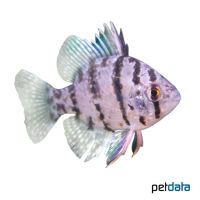Blackbanded Sunfish (Enneacanthus chaetodon)
| Blackbanded Sunfish Enneacanthus chaetodon | |
|---|---|
| Name | Blackbanded Sunfish |
| Name Lat. | Enneacanthus chaetodon |
| Family | Sunfishes |
| Family lat. | Centrarchidae |
| Order | Basses |
| Order lat. | Centrarchiformes |
| Origin | SE-USA |
| Habitat | Rivers, ponds, lakes |
| Diet | Carnivore |
| pH | 6.5-7.5 |
| Behavior | Peaceful |
| Keeping | Pair, group |
| Care Level | Easy |
| Reproduction | Substrate spawner |
| Breeding | Moderately difficult |
| Life Span | 5-8 years |
| Protection | No |
| Metric Units | |
| Size | 5-10 cm |
| Temperature | 4-25 °C |
| Hardness | 10-15 °dH |
| Aquarium | 100 l or ponds |
| US Units | |
| Size | 2"-4" |
| Temperature | 39-77 °F |
| Hardness | 178-267 ppm |
| Aquarium | 25 gal or ponds |
Distribution and habitat
The original distribution area of the disc bass is the eastern USA, from New Jersey to Florida. They live in calm, weedy waters, such as ponds, lakes, and stillwater of rivers with a soft, sandy bottom. They were introduced to Europe in the 19th century and released animals now live in many ponds, rivers and lakes.
Maintenance
The pond should be furnished with pond, floating and especially oxygenating underwater plants (milfoil, waterweed, hornwort, etc.), large river pebbles, and a substrate of sand and round-grained gravel, and provide plenty of free swimming space.
When maintaining in a cold water aquarium (from 80 cm / 112 l), it is important to ensure that a large swimming space is available in addition to dense marginal planting and numerous hiding places (roots, stones). A soft substrate, oxygen-rich water and slightly shaded light (floating plants) is ideal
No ammonia, ammonium and nitrite should be detectable in the water, and the nitrate value should not exceed 100 mg/l. To ensure the water quality and oxygen content should not be missing a filter adapted to the water volume.
Diet
They are predatory fish that feed on insects, small crustaceans, fish spawn and small fish. The food supply consists of live food, such as daphnia, artemia, mysis, tubifex, mosquito larvae, etc., which is also accepted without problems in frozen form, or a commercially available frozen food mix. High-quality, protein-rich dry food is also occasionally accepted.
Behaviour and compatibility
They should be kept in pairs in the aquarium and in a group in the pond. At spawning time they behave very territorial, so keeping several pairs is recommended only in a larger and richly structured tank. They can be well socialized with other not too small fish
Basically, only compatible fish species with similar demands on water quality and water temperature should be socialized.
Reproduction and breeding
The sexes are difficult to distinguish. The females are more vividly colored in the spawning season.
They spawn in May and June, from a water temperature of about 16 °C. The male creates a spawning pit under the protection of rocks and plants. After the female has laid the eggs, the male takes over the brood care and defends the territory. After 2-3 days the fry hatch and are guarded by the male for another 1-2 weeks before the brood care ends.
In the aquarium, the fry must be fed several times a day with special rearing food. In community tanks breeding is hardly possible, because the fry are easy prey here.
Important
They are sensitive to sudden water changes or temperature fluctuations. If they are used to reduce unwanted offspring of other pond fish, it should be borne in mind that the discfish themselves can reproduce strongly.
If they are overwintered in the pond, sufficient depth and oxygen supply (filter, oxygen dispenser, ice free holder) must be provided
At temperatures below 8-10 °C, the metabolism of the fish slows down and food is no longer accepted; feeding must be stopped accordingly. If the temperature drops further, they hibernate near the bottom. In spring, with rising temperatures, feeding can slowly be resumed. Feeding may also be necessary during prolonged warm periods in winter.
The well-being of the fish should be monitored regularly. A regular partial water change, according to the pond size is recommended, even if the pollutant load has not yet reached the upper limit. Sudden changes in water quality should be avoided. Newly introduced fish must be accustomed slowly to the water in the pond or aquarium
Further literature can be found in your pet store.
References
Text: petdata; Image: petdata
Source: BMELV (1998): Tierschutzgutachten - Haltung von Zierfischen (Süßwasser); RIEHL & BAENSCH (2006): Aquarien Atlas Bd. 1, Mergus Verlag; ENGELMANN (2005): Zootierhaltung - Tiere in menschlicher Obhut: Fische; Harri Deutsch Verlag
- Gemäß § 21 Abs. 5 Tierschutzgesetz idgF
